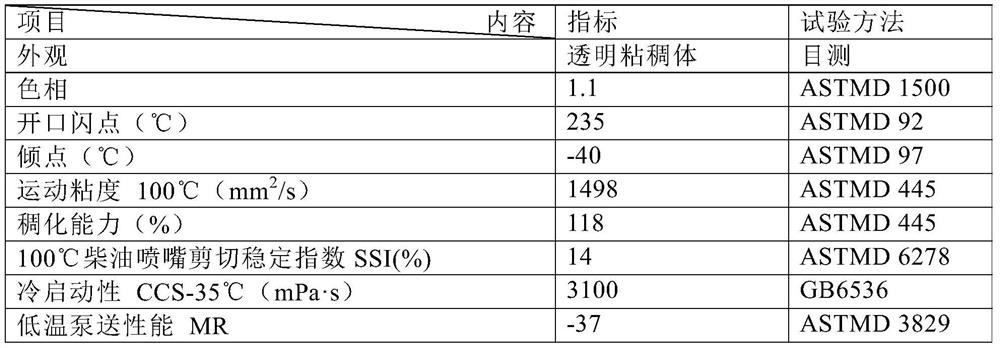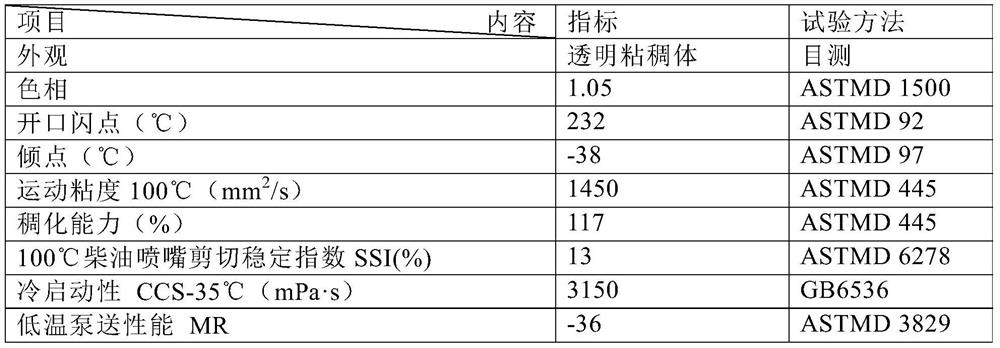A kind of method of polymer modified lubricating oil
A polymer and lubricating oil technology, applied in the field of lubricating oil, can solve the problems of inability to increase viscosity, high viscosity, and affect the viscosity-temperature characteristics of lubricating oil, and achieve the improvement of fluidity, high viscosity, and excellent viscosity-temperature characteristics. Effect
- Summary
- Abstract
- Description
- Claims
- Application Information
AI Technical Summary
Problems solved by technology
Method used
Image
Examples
specific Embodiment approach 1
[0038] Specific embodiment 1: the polymer is a hydrogenated styrene-butadiene block polymer, and the method for preparing a hydrogenated styrene-butadiene block polymer solution comprises: mixing styrene monomer and butadiene monomer Polymerization is carried out under solution polymerization conditions, and then the prepared styrene-butadiene block polymer solution is subjected to hydrogenation reaction to prepare a hydrogenated styrene-butadiene block polymer solution. The catalyst for the polymerization reaction is preferably a lithium catalyst, the temperature of the polymerization reaction is 35-110° C., the pressure of the polymerization reaction is 0.15-0.8 MPa, and the total reaction time of the materials in the polymerization reactor is 60-180 minutes. And the catalyst of the hydrogenation reaction is preferably a nickel-based catalyst, the temperature of the hydrogenation reaction is 40-80°C, the pressure of the hydrogenation reaction is 2.0-6.0MPa, and the total reac...
specific Embodiment approach 2
[0040] Specific embodiment 2: the polymer is a hydrogenated styrene-isoprene block polymer, and the method for preparing a hydrogenated styrene-isoprene block polymer solution includes: mixing styrene monomer and isoprene Carry out polymerization reaction of alkene monomer under solution polymerization reaction conditions, then carry out hydrogenation reaction to the prepared styrene-isoprene block polymer solution, obtain hydrogenated styrene-isoprene block polymer solution . The catalyst for the polymerization reaction is preferably a lithium-based anion catalyst, the temperature of the polymerization reaction is 50-90° C., the pressure of the polymerization reaction is 0.15-0.7 MPa, and the total reaction time of the materials in the polymerization reactor is 50-150 minutes. And the catalyst of the hydrogenation reaction is preferably a nickel-based catalyst, the temperature of the hydrogenation reaction is 50-70°C, the pressure of the hydrogenation reaction is 3.0-5.0MPa, ...
Embodiment 1
[0056] The polymerization conditions used in this example are: the weight ratio of ethylene monomer, propylene monomer and n-hexane is 1:4:16; the vanadium-based Ziegler-Natta catalyst is used, and the temperature of the first polymerization reactor is 35°C, pressure 0.8MPa, average residence time 15min; temperature of the second polymerization reactor 48°C, pressure 1.0MPa, average residence time 15min. The binary ethylene-propylene rubber glue solution (the number-average molecular weight of this binary ethylene-propylene rubber is 105,000, the molecular weight distribution coefficient is 1.8, the content of propylene structural unit is 49% by weight, the Mooney viscosity of finally obtaining concentration is 7% by weight, Mooney viscosity is 47), and the production capacity of pure binary ethylene propylene rubber is 20kg / h, and the obtained binary ethylene propylene rubber glue is introduced into a lubricating oil blending tank with stirring at a flow rate of 285kg / h, and t...
PUM
| Property | Measurement | Unit |
|---|---|---|
| molecular weight distribution | aaaaa | aaaaa |
| molecular weight distribution | aaaaa | aaaaa |
Abstract
Description
Claims
Application Information
 Login to View More
Login to View More - R&D
- Intellectual Property
- Life Sciences
- Materials
- Tech Scout
- Unparalleled Data Quality
- Higher Quality Content
- 60% Fewer Hallucinations
Browse by: Latest US Patents, China's latest patents, Technical Efficacy Thesaurus, Application Domain, Technology Topic, Popular Technical Reports.
© 2025 PatSnap. All rights reserved.Legal|Privacy policy|Modern Slavery Act Transparency Statement|Sitemap|About US| Contact US: help@patsnap.com



